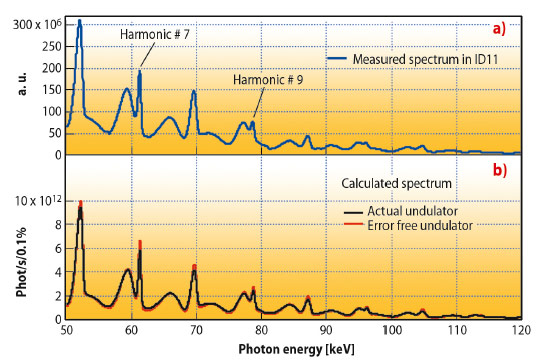- Home
- Users & Science
- Scientific Documentation
- ESRF Highlights
- ESRF Highlights 2012
- Accelerator and X-ray Source
- Cryogenic permanent magnet undulators
Cryogenic permanent magnet undulators
Over the last five years, the Insertion Devices Group has played a major role in the development of cryogenic permanent magnet undulators (CPMUs). From the conventional technology of in-vacuum undulators (IVUs) the step toward CPMUs is a straightforward evolution. Due to the cryogenic cooling of the permanent magnet arrays, very high remanence NdFeb or PrFeB permanent magnet materials can be used to increase the undulator peak field. For a similar period and gap, the peak field of a CPMU is typically 40% higher than that of an IVU based on Sm2Co17 material. One key feature of CPMUs is the large resistance to radiation induced demagnetisation reached by the permanent magnet material at cryogenic temperature (80 K to 140 K), an essential aspect for further reduction of the magnetic gap (5 mm or less).
The first use of a CPMU on a storage ring was achieved at the ESRF in 2008 [1]. Installed in the ID06 straight section, this device has provided essential feedback on many technological aspects and also on the compatibility of CPMUs with the operation of a large-scale facility like the ESRF. Based on the experience of this first prototype, a second device was built and has been recently installed on the ID11 straight section. This undulator has a period of 18 mm and a total magnetic length of 2 m. The selected NdFeB material has a magnetic remanence of 1.55 T at 145 K resulting in a peak field of 1 T for the undulator at a gap of 6 mm (K = 1.68). The measured X-ray spectrum from the CPMU on ID11 reveals a remarkable agreement with the expected spectrum. Figure 151a shows the recorded spectrum on high harmonics (≥ 6) in an aperture of 600 µm x 600 µm at 30 m from the source. The undulator gap was 6.4 mm in this case. Figure 151b presents the calculated spectrum in the same conditions for an error free undulator (red) and the actual undulator using the magnetic measurements performed at 145 K (black). It confirms the methods used for the magnetic measurements which need to be performed under vacuum with the undulator at cryogenic temperature. As expected, the recorded photon flux at photon energy above 70 keV is up to three times higher than that of the neighbouring ID11 IVU (period 22 mm, K = 1.74 at a gap of 6 mm).
 |
|
Fig. 151: a) Recorded spectrum from the new CPMU in ID11; b) Calculated spectra for an error-free undulator (red) and actual undulator (black). |
Since the restart of the accelerator in May 2012, the operation of the new CPMU has been smooth and without any specific difficulty. A survey of undulator temperature shows a stable working point evolving from 140 K in 4 bunch mode up to 146K in 16 bunch mode with the undulator gap closed to below 7 mm. In the ESRF context, the use of CPMUs is primarily efficient for improving the brilliance at photon energies above 50 keV. A further development, combining a smaller magnetic gap and better permanent magnet materials is presently under study. This is a very short period device (14 mm) with a K value of 1.65 at a gap of 4 mm.
References
[1] First Operational Experience with a Cryogenic Permanent Magnet Undulator at the ESRF, J. Chavanne, G. Lebec, C. Penel and F. Revol, Proc. PAC09, p. 21414, 2416, Vancouver, 2009.



